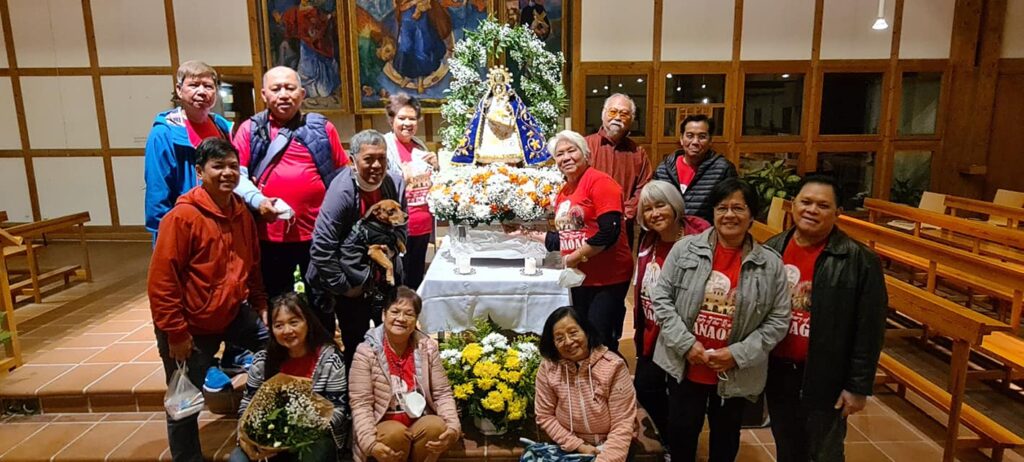- Hector Pascua/Pictures: Mandy Salonga
For Catholics worldwide, the month of October is dedicated to Our Lady of the Holy Rosary. It is one of the major Marian feast days particularly for devotees of the Blessed Virgin Mary and believers of the significance and powers of the Holy Rosary.
The feast day of Our Lady of the Most Holy Rosary of Manaoag likewise falls in October and is consistently celebrated by Filipino migrants in Austria, particularly the natives of Manaoag, Pangasinan, a town which is about more than 100 miles north of Manila.
The original image of Our Lady of Manaoag is currently enshrined at the Parish of the Heart of Jesus, in Vienna’s 21st District. However, the big feast in October took place on October 3, 2021 in the Filipino Catholic chaplaincy in 10th District, Vienna. A high mass was celebrated by Fr. Ely Dalanon, Chaplain of the Filipino Catholic Community.
A nine-day novena with the recitation of the Holy Rosary commenced the celebration.
It is reported that the image of Our Lady has performed miracles based on various testimonies inscribed at the said church’ murals and accounts by people who have received tremendous help and favors granted.

Our Lady of Manaog is “canonically crowned image of our Lady of the Holy Rosary, duly recognized by the Vatican and enshrined in a church under the Dominican Order in the Philippines”.
The Association of Pangasinenses in Austria organizes the annual celebration of our lady of Manaoag.
The History of Our Lady of Manaoag
Our Lady of Manaoag (formal title: Our Lady of the Most Holy Rosary of Manaoag) is a Roman Catholic title of the Blessed Virgin Mary venerated in Manaoag, Pangasinan, the Philippines.
The statue of Our Lady of Manaoag is a 17th-century ivory and silver image of the Virgin Mary with the Child Jesus enshrined at the high altar of the Basilica.
It was brought to the Philippines from Spain via the Manila galleon trade from Acapulco, Mexico, in the early 17th century by Padre Juan de San Jacinto. Documents dating back to 1610 attest that a middle-aged farmer walking home heard a mysterious female voice. He looked around and saw on a cloud-veiled treetop an apparition of the Virgin Mary, holding a Rosary in her right hand and the Child Jesus in her left arm, all amidst a heavenly glow. Mary told the farmer where she wanted her church to be built, and a chapel was built on the hilltop site of the apparition, forming the nucleus of the present town. The shrine is a major pilgrimage site in the country and is administered by the Order of Preachers within the Archdiocese of Lingayen-Dagupan. Pope Pius XI granted a Canonical Coronation to the image on 22 April 1926, while Pope Benedict XVI raised her sanctuary in equal indulgences to the Basilica of Saint Mary Major on 21 June 2011.
Under this Marian title, the Blessed Virgin Mary is invoked as patroness of the sick, helpless and needy. She is celebrated on two feast days: the third Wednesday after Easter and first Sunday of October.
Her miracles are numerous and are not only part of the past but continue to adorn the present. Hence so strong is the devotion her devotees have for her that whatever they may find themselves they do not fail to visit her to ask that Masses be said for them at her shrine or that candle be lighted on their behalf before her. Some send flowers to decorate her throne and others even prepare a cloak for her to wear. Along the walls of her shrine the more famous miracles attributed to her are depicted in giant wall paintings. One reveal the story of a sick child from Bonmaley who died on the way to the Lady’s shrine. His dead body was nevertheless brought to the shrine before the feet of Our Lady and there it was brought back to life to the joy of his parents. One other well-known miracle is what happened to a man from Dagupan whose throat was infected from fishbone he swallowed. He was cured when water that was used to wash Our Lady’s hands was poured into the dying man’s lips.
People from all walks of life and almost all part of the country flock to her either to thank her for favors received through her intercession or to petition her once more for favors or graces or simply to honor her.
The Virgin has assured the people of Manaoag of her protection on several occasions. During the early times when mountain tribes used to burn Christian villages, Manaoag was not spared. It was set on fire. The church with its thatched roof was the last refuge of the people. But the leader of the pillagers, climbed over the fence and shot lighted arrows to all parts of the church. Not a single flame, however, set it on fire. This miraculous event was repeated during the World War II. In spite of several bombs that found their way into the church, not one of them exploded thus keeping the shrine intact.
This post has already been read 1950 times!



